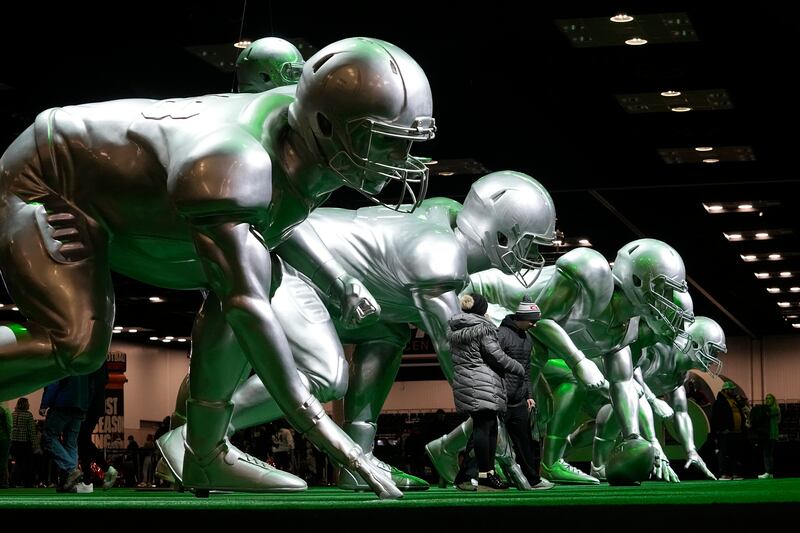College football is at a crossroads, facing major challenges from the NIL rule and the transfer portal. Whoever is in charge of the game — if there is anyone — didn’t know what they were unleashing when those two rule changes were adopted, and now the game has been turned upside down with teams exploiting those rules. That’s what happens when millions of dollars are at stake.
The combination of name, image and likeness policies and the transfer portal has created an easy means for the rich programs to lure away players from other schools with offers of money, besides giving them a huge advantage in high school recruiting. Utah athletic director Mark Harlan offered the most stunning example and made national headlines when he revealed that a Utah football player had been offered a million dollars to transfer to another school.
Harlan, Utah football coach Kyle Whittingham and Alabama coach Nick Saban are among the many who have sounded the alarm, but do those who run college football — Power Five conference presidents, commissioners and athletic directors, the NCAA — really want to change anything? You have to wonder why the obvious flaws of the NIL/portal rules haven’t been addressed already. You also have to wonder if the power brokers of college football really want do anything about them at all?
They have conflicts of interest. They’re the ones who have the means to exploit the new rules, and, furthermore, the NIL rule has done them a huge favor. What incentive do they have to change the current state of affairs? They faced a big problem when athletes and their advocates were demanding that the sport share its billions of dollars in revenue with the athletes. It was inevitable that eventually they would have to cave in and pay the players in some fashion. The NIL bailed them out.
Talk about a gift falling in their laps. NIL enables a third party — boosters and local businesses — to step in and pay the bill for them. It costs college football’s powers-that-be almost nothing except what little endorsement revenue they might have garnered that instead goes to a handful of athletes now. A third party has let them off the hook. The elites of the college game must be doing cartwheels over this thing. It’s as if Amazon employees went on strike demanding a raise, and Apple offered to pay the difference for them.
The real root of college football’s problem is that no one is overseeing college football as a whole; it’s devolved into a turf war and each kingdom is fighting for its slice of the pie. It’s all about self-interest.
So maybe none of the haves in college football care that the NIL/portal problem will create a larger divide between the haves and have-nots, with the rich schools able to offer buckets of money to prep recruits and proven players at other schools. As Whittingham put it so well, “… There’s going to come a time in the very, very near future where the top 25 NIL pots of money are going to mirror almost exactly the top 25 programs in the country.” Under NIL rules, the schools with the richest, most generous boosters and businessmen will thrive. They can buy recruits and buy other team’s players. The Group of Five conferences will be farm teams for the Power Five.
Saban complained about it by pointing a finger at a rival school last spring. “(Texas) A&M bought every player on their team,” he said. “Made a deal for name, image and likeness. We didn’t buy one player. But I don’t know if we’re gonna be able to sustain that in the future because more and more people are doing it.”
On the other hand, Saban told reporters in the summer of 2021 that his sophomore quarterback had been paid almost $1 million in NIL money, a player who had thrown only 22 collegiate passes. “... It’s almost seven figures,” Saban told The Athletic. “And it’s like, the guy hasn’t even played yet. But that’s because of our brand.”
Saban probably made that public knowing the money would be a lure for Alabama recruits.
The original intent of the NIL rule was to allow players to make money off their own name via autographs, appearances and advertising (previously the NCAA owned their image in perpetuity). NIL has morphed into something else. It’s changed into boosters (collectives) offering money to induce players to leave schools and join their school.
Last April, Saban told The Associated Press, “I don’t think what we’re doing right now is a sustainable model. The concept of name, image and likeness was for players to be able to use their name, image and likeness to create opportunities for themselves. That’s what it was. So last year on our team, our guys probably made as much or more than anybody in the country.
“But that creates a situation where you can basically buy players. You can do it in recruiting. I mean, if that’s what we want college football to be, I don’t know. And you can also get players to get in the transfer portal to see if they can get more someplace else than they can get at your place.”
For decades college football has always been one of the most poorly run, nonsensical sports in the world, with its refusal to adopt a playoff, for its draconian and archaic rules to maintain amateurism, with its lack of parity, with its goofy poll and bowl systems. Who could imagine things could be worse.
And now they are.



